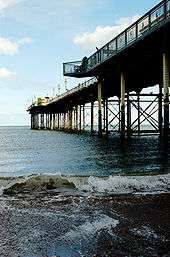Grand Pier, Teignmouth
The Grand Pier, also known as Teignmouth Pier, is a pier in the town of Teignmouth, Devon, England. It measures 212 metres (696 ft) in length. It was designed by J W Wilson and constructed between 1865 and 1867.[1]

| Official name | Grand Pier |
|---|---|
| Type | Pleasure Pier |
| Designer | J W Wilson |
| Total length | 212 metres (696 ft) |
| Opening date | 1867 |
| Coordinates | 50.5447°N 3.4942°W |
History
A total of 89 piers were built in England and Wales between 1814 and 1910 of which only 50 are still standing. Teignmouth Pier was built in 1865 by Joseph Wilson, an engineering consultant from London. As a boy, Wilson yearned to be an engineer, much to his father's disapproval, he had always hoped that he would follow the family tradition and take up a clerical post. After his son's initial schooling as a cleric, Joseph's father was eventually persuaded to send him, as an apprentice, to work under his cousin's tutelage in Fox and Henderson, an engineering firm. Later on in his career, he acted as an assistant engineer for the firm, on the construction of Crystal Palace, London. He had an inventive mind, and introduced many improvements to the machinery used on the construction. When he left there, he set up in partnership with his brother-in-law and opened The Oldbury Engineering Works. Then, due to ill health, he left Oldbury and set up as a Consulting Engineer in Banbury, where he and his son carried out the construction of Teignmouth Pier. Joseph Wilson died in 1898.
Initially, the pier was a landing stage; its purpose was to enable steamboat passengers to get to the shore.
In March 1870, a petition to wind up the Teignmouth Pier Company Limited was published in The London Gazette.[2]
The pier is constructed of cast-iron screw piles, screwed into the sand with a large hexagon on the pile. They are screwed down to the clay level. New steel piling has been driven 80ft right to bedrock. The deck is open and made up of wood from the Yellow Balou, a hard wood from Borneo. The deck was only recently renewed.
During the Second World War, a 60–foot section of deck was removed so that the Germans could not breach if they invaded England. Nearly all the piers on the East and South coasts were dealt with in the same way. Compensation was paid out for replacement of that section but many remained in that state for a considerable period. The Grand was not brought to its original width until the early 1960s.
References
- "Teignmouth Pier - History". Heritage Trail. Archived from the original on 25 July 2008. Retrieved 12 December 2008.
- "In the Matter of the Companies Acts, 1862 and 1867, and of the Teignmouth Pier Company Limited" (PDF). The London Gazette. 8 March 1870. Retrieved 5 May 2013.